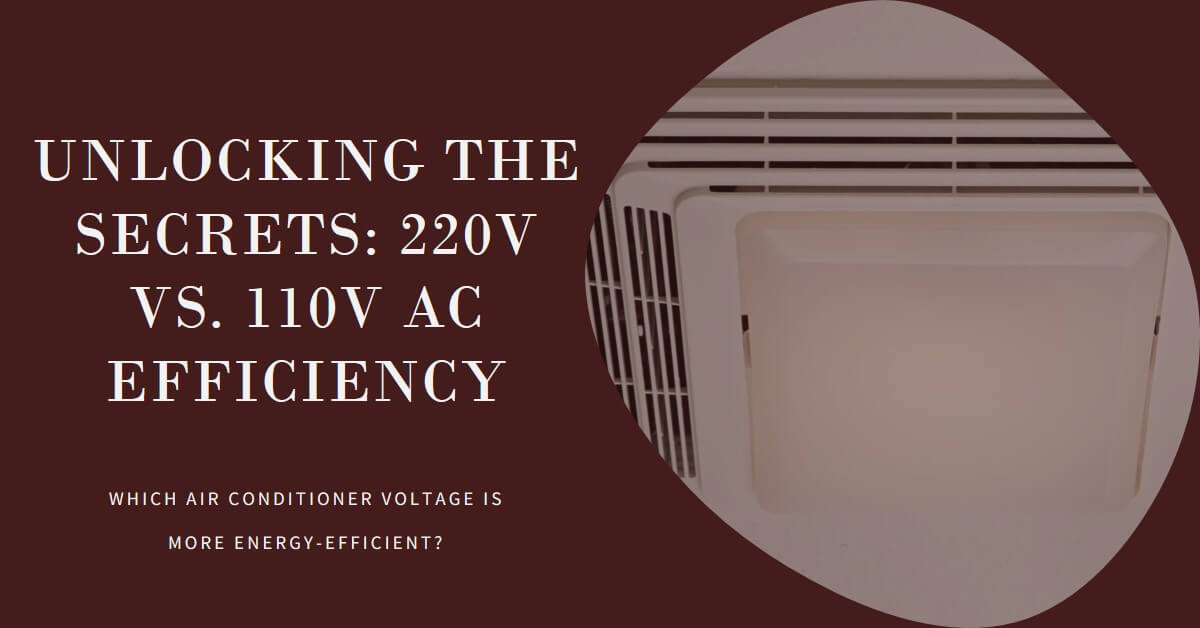Image: “Article Feature Image” by Bing, Source: [Bing Graphic Art].
Air conditioners play a vital role in keeping our indoor spaces cool and comfortable, especially during the sweltering summer months.
However, energy efficiency has become a crucial consideration for many consumers. 220V air conditioners generally tend to be slightly more energy-efficient than 110V models due to lower current requirements, but efficiency can vary based on specific design and technology.
In this article, we will explore the question of whether a 220v air conditioner is more efficient than a 110v one, shedding light on the factors influencing efficiency and providing recommendations for choosing the right air conditioner.
Understanding Voltage in Air Conditioners
Voltage refers to the electrical potential difference required to operate an appliance. Standard voltage levels for air conditioners include 220v and 110v, each with its own applications and benefits.
Factors Affecting Air Conditioner Efficiency
Certainly! Here’s a more detailed explanation of the factors that contribute to the overall efficiency of an air conditioner:
- Cooling Capacity: The cooling capacity of an air conditioner refers to its ability to remove heat from the indoor space and provide a comfortable temperature. It is typically measured in British Thermal Units (BTUs) and indicates how much heat the unit can transfer in a given period. A higher cooling capacity allows the air conditioner to cool a larger area effectively.
- Power Consumption: Power consumption is the rate at which an air conditioner uses electrical power to operate. It is measured in watts and determines the electrical load that the air conditioner places on the electrical system. While power consumption remains the same for both 220v and 110v air conditioners with the same power rating, other factors can influence their overall efficiency and performance.
- Efficiency Ratings: Air conditioners are often assigned efficiency ratings, such as Seasonal Energy Efficiency Ratio (SEER) or Energy Efficiency Ratio (EER). These ratings indicate the unit’s energy efficiency by measuring the cooling output in relation to the energy input. Higher efficiency ratings signify more energy-efficient units that provide greater cooling output per unit of energy consumed.
By considering these factors collectively, consumers can assess the overall efficiency of an air conditioner and make informed choices that align with their cooling needs, energy efficiency goals, and budget constraints.
Opting for an air conditioner with higher cooling capacity, better energy consumption ratings, and efficient components can contribute to a more efficient and cost-effective cooling experience.
Efficiency Comparison: 220v vs. 110v Air Conditioners
Comparing the efficiency of 220v and 110v air conditioners is essential in understanding their performance and effectiveness in cooling spaces.
While factors like cooling capacity and energy consumption can vary between the two voltage types, it is important to note that power consumption, measured in watts, remains the same.
Both 220v and 110v air conditioners consume the same amount of power to generate cooling.
Advantages of a 220v Air Conditioner
A 220v air conditioner offers several advantages that contribute to its overall efficiency. These include higher cooling capacity, which allows it to cool larger spaces more effectively.
Additionally, 220v air conditioners tend to have lower operating currents compared to their 110v counterparts, reducing electrical losses and improving overall efficiency. The reduced current also helps minimize voltage drop, ensuring consistent performance.
Advantages of a 110v Air Conditioner
While 220v air conditioners have their advantages, 110v air conditioners also offer unique benefits. They are typically more widely available and compatible with standard household electrical systems in the United States.
This widespread availability can make it easier to find suitable units and reduce installation costs. 110v air conditioners are also well-suited for smaller spaces, where their cooling capacity is sufficient.
Cooling efficiency
When comparing the cooling efficiency between 220v and 110v air conditioners, it’s important to consider factors such as cooling capacity and time taken to cool a space.
Assuming we compare two air conditioner units with the same power rating, the 220v air conditioner typically has a higher cooling efficiency.
This is because higher voltage allows for a more robust and efficient operation, enabling the compressor and other components to work optimally.
The higher cooling capacity of 220v air conditioners enables them to cool larger spaces more effectively, ensuring quicker temperature reduction compared to 110v units.
In practice, a 220v air conditioner can cool a room faster than a 110v air conditioner with the same power rating due to its enhanced performance capabilities.
This is particularly advantageous in hot climates or for spaces with high cooling demands, as it ensures a more rapid and effective cooling experience.
However, it’s important to note that the actual cooling efficiency also depends on other factors such as insulation, room layout, and environmental conditions.
Considering the cooling efficiency and the ability to cool spaces faster, a 220v air conditioner with a comparable power rating offers distinct advantages in achieving quicker and more efficient cooling, particularly for larger rooms or areas with higher cooling requirements.
Read also my article: Voltage Clash: Running a 110V Air Conditioner on 220V Power.
Considerations When Choosing between 220v and 110v
When deciding between a 220v and 110v air conditioner, several crucial factors should be considered. These include the electrical infrastructure and compatibility of the building, the size of the room and cooling requirements, budget constraints, and energy efficiency goals.
By evaluating these factors, consumers can determine which voltage option aligns best with their specific needs.
Energy Savings and Cost Analysis
To determine the long-term benefits of choosing a specific voltage for an air conditioner, it’s essential to analyze energy savings and cost implications.
While power consumption remains the same for both 220v and 110v air conditioners, other factors such as cooling capacity and overall efficiency can influence energy usage and costs.
Evaluating these factors in conjunction with local electricity rates can help estimate potential energy savings and cost implications over time.
Recommendations for Choosing the Right Air Conditioner
Based on the information and analysis presented, we offer recommendations for choosing the most suitable air conditioner.
Factors such as room size, electrical infrastructure compatibility, and long-term cost implications should be carefully considered.
It’s also crucial to prioritize energy efficiency goals and select a unit that aligns with those objectives. By considering these factors holistically, consumers can make an informed decision that balances their cooling needs with energy efficiency considerations.
Conclusion
In conclusion, while power consumption remains the same for both 220v and 110v air conditioners, other factors such as cooling capacity and overall efficiency can vary
between the two voltage types. 220v air conditioners often offer advantages such as higher cooling capacity and lower operating currents, making them more efficient for larger spaces.
However, 110v air conditioners are more widely available, compatible, and suitable for smaller areas. By carefully considering factors such as room size, electrical infrastructure, and long-term cost implications, consumers can make the right choice to achieve optimal cooling comfort while minimizing energy consumption.

